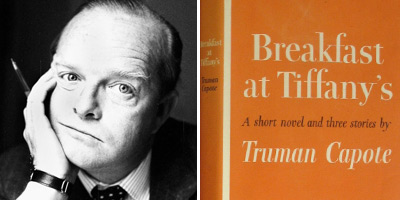How Truman Capote’s Breakfast at Tiffany’s Gave Birth to a Cultural Icon and a Provocative Broadway Play
There’s no name more synonymous with window shopping on Fifth Avenue than Holly Golightly, the goodtime girl at the center of Truman Capote’s classic novella-turned-movie Breakfast at Tiffany’s. Now that Holly has hit Broadway in a new play written by Tony winner Richard Greenberg and starring Game of Thrones favorite Emilia Clarke, we’re taking a look back at how this swanky character became a bona fide pop culture gem.

The Birth of Holly Golightly
In 1958, author Truman Capote was already a celebrity when he published his now-iconic Breakfast at Tiffany’s: A Short Novel and Three Stories. Capote declared that the titular novella launched the second cycle of his writing career, following the success of his first novel, Other Voices, Other Rooms.
Breakfast at Tiffany's is narrated by a young, nameless writer dubbed “Fred” who becomes fascinated with his mysteriously eccentric, social climbing neighbor Holly Golightly, reportedly an amalgam of many society women Capote knew (including Gloria Vanderbilt, Oona Chaplin and model Suzy Parker).
Holly became the writer’s most famous (and his favorite) creation, a character whose name said it all: a happy-go-lucky wanderer who bounced through life like a holiday. “She’s got this never-ending energy,” Emilia Clarke told Broadway.com. “She is shrouded in mystery, but at the same time is incredibly effervescent and someone you want to be around.”
Capote sold the story for $2,000 to Harper’s Bazaar, but the magazine feared that Tiffany’s’ adult language and sexual content would offend both readers and the folks at Tiffany & Co., a major advertiser. Esquire picked up the manuscript and published it serially in 1958. The publicity was enormous, and Hollywood was immediately interested.

Holly Goes to Hollywood
Film producer Richard Shepherd optioned the rights to Capote’s novella and took it to Paramount, where the film entered development with contract actress Audrey Hepburn in the lead role. Capote wanted Marilyn Monroe, arguing that the prim and proper Hepburn was completely miscast.
Screenwriter George Axelrod’s sanitized script was markedly different from the novella. Holly’s profession as a high-end call girl—which was addressed directly in the book—was dialed down in the film, along with her age, bisexual curiosity and propensity for marijuana. Similarly, the film’s ending was made more upbeat, the setting was changed from wartime 1940s to 1960, and the gayness of the male narrator (played by George Peppard) was completely eliminated.
Still, director Blake Edwards' film, released in October 1961, was a whopping success, earning two Oscars (including one for Henry Mancini's haunting hit "Moon River," sung by Hepburn on a fire escape) and catapulting its star into cultural icon status. Both the film and the book caused dozens of women to claim they had inspired Holly; one named Bonnie Golightly even went so far as to file a libel lawsuit against Capote, though it was ultimately unsuccessful. Capote called the entire sensation the "Holly Golightly Sweepstakes."

Culture Pops for Capote
Though the novella and film became undeniable classics, Tiffany’s entered pop culture in other media as well, including a never-seen ABC pilot for a sitcom titled Holly Golightly starring Stefanie Powers and Jack Kruschen. Of all the adaptations, perhaps most memorable was a notorious 1966 musical version, which was pulled from Broadway after four previews.
Breakfast at Tiffany’s the musical starred Mary Tyler Moore and Richard Chamberlain and featured music and lyrics by Bob Merrill of Funny Girl fame and a book by Edward Albee (replacing an earlier draft by Abe Burrows). The out-of-town tryouts were chaos, with some versions of the show running more than four hours. Holly & Co. limped into Broadway's Majestic Theatre, but producer David Merrick quickly shuttered the musical and placed an infamous ad in The New York Times declaring that he refused to “subject the drama critics and the public to an excruciatingly boring evening.”
Playwright Samuel Adamson adapted the novella in 2009 for the Theatre Royal Haymarket in London. Pushing Daisies starlet Anna Friel played Holly, with Joseph Cross as Fred. (Critics liked Friel, who did a nude scene; the script, not so much.) The production was directed by Sean Mathias, who would go on to helm the 2013 Broadway adaptation.

Broadway Has Breakfast
In October 2012, producers announced their intention to bring Breakfast at Tiffany’s back to the Broadway stage in a new adaptation by Richard Greenberg, a Tony winner for his baseball-themed comedy Take Me Out. Mathias reprises his role as director, with Emilia Clarke as Holly. “Having an actor play the right part at the right moment when the world doesn’t really know them and they go, ‘Oh my gosh, who is that person?’ That’s what we have with Emilia,” Mathias told Broadway.com.
Joining Clarke are Broadway newcomer Cory Michael Smith as Fred and Cheers star George Wendt as bartender Joe Bell (a major character in the novella). The adaptation is based entirely on the book, so audience members expecting the a carbon copy of the film will certainly be in for a surprise (including at least one nude scene). Still, the play promises to be a nostalgic night at the theater for anyone enamored with the character of Holly Golightly.
“Fundamentally, we’re not doing the movie,” explained Clarke. “There will still be people coming to see the show who maybe might expect it, but they’ll get something quite different...but pretty damn special.”
Breakfast at Tiffany’s opens at the Cort Theatre on March 20.

